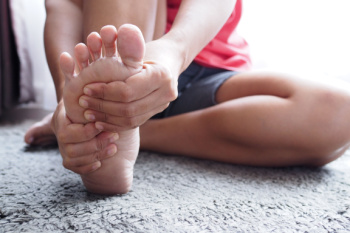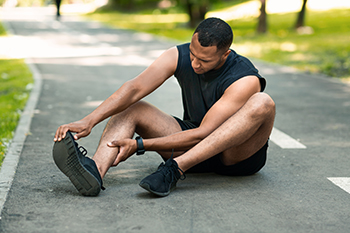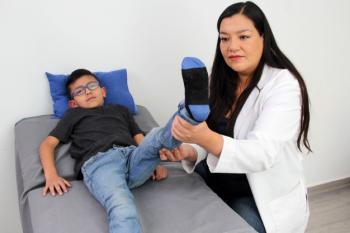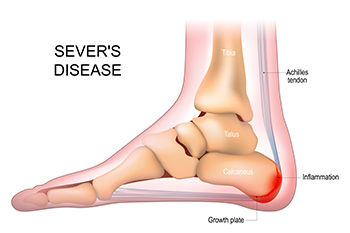June 2024
Osteoarthritis and the Feet
 Osteoarthritis is a degenerative joint disease that commonly affects older adults, particularly in the feet and ankles. It occurs when the cartilage that cushions the joints breaks down, leading to pain, swelling, and reduced mobility. This condition is caused by the natural aging process, repetitive stress on the joints, or previous injuries. Individuals who are overweight, have a family history of arthritis or have jobs that place continuous stress on their feet are at greater risk. Diagnosis typically involves a physical examination, imaging tests like X-rays, and sometimes blood tests to rule out other conditions. Treatment focuses on managing symptoms and may include lifestyle changes, exercises, medications, or in severe cases, surgery. Maintaining a healthy weight, wearing supportive footwear, and engaging in low-impact exercises can help manage the condition. For specialized care and management, visiting a podiatrist is suggested.
Osteoarthritis is a degenerative joint disease that commonly affects older adults, particularly in the feet and ankles. It occurs when the cartilage that cushions the joints breaks down, leading to pain, swelling, and reduced mobility. This condition is caused by the natural aging process, repetitive stress on the joints, or previous injuries. Individuals who are overweight, have a family history of arthritis or have jobs that place continuous stress on their feet are at greater risk. Diagnosis typically involves a physical examination, imaging tests like X-rays, and sometimes blood tests to rule out other conditions. Treatment focuses on managing symptoms and may include lifestyle changes, exercises, medications, or in severe cases, surgery. Maintaining a healthy weight, wearing supportive footwear, and engaging in low-impact exercises can help manage the condition. For specialized care and management, visiting a podiatrist is suggested.
Arthritis can be a difficult condition to live with. If you are seeking treatment, contact Dr. Eugenio Rivera from Calo Foot & Ankle Specialists. Our doctor can provide the care you need to keep you pain-free and on your feet.
Arthritic Foot Care
Arthritis is a joint disorder that involves the inflammation of different joints in your body, such as those in your feet. Arthritis is often caused by a degenerative joint disease and causes mild to severe pain in all affected areas. In addition to this, swelling and stiffness in the affected joints can also be a common symptom of arthritis.
In many cases, wearing ill-fitting shoes can worsen the effects and pain of arthritis. Wearing shoes that have a lower heel and extra room can help your feet feel more comfortable. In cases of rheumatoid arthritis, the arch in your foot may become problematic. Buying shoes with proper arch support that contour to your feet can help immensely.
Alleviating Arthritic Pain
- Exercises that stretch the foot can prevent further pain and injury and increase mobility
- Most of the pain can be alleviated with anti-inflammatory drugs, heat, and topical medications
- Massages can help temporarily alleviate pain.
It is best to see your doctor for the treatment that is right for your needs and symptoms. Conditions vary, and a podiatrist can help you determine the right method of care for your feet.
If you have any questions, please feel free to contact our office located in Bellaire, TX . We offer the newest diagnostic tools and technology to treat your foot and ankle needs.
Tips for Preventing Running Injuries

Whether you're a novice runner or a seasoned marathoner, injury prevention is a top priority. An important aspect of running injury prevention is having a structured plan and progressing slowly. Avoiding increasing your total mileage by more than 10 percent each week helps prevent overexertion and gives your muscles and ligaments adequate time to adapt. It's also essential to strike a balance between increasing distance and improving speed. Focusing on one aspect at a time can reduce the risk of overuse injuries. Proper hydration, replenishing your body with a combination of protein and carbohydrates within 30 minutes post-run, and practicing deep breathing exercises to stimulate a relaxation response can all aid in muscle repair and reduce soreness. Incorporating cross-training activities such as swimming or cycling into your routine provides a welcome break from the impact of running. Dynamic stretches before your run help prime your muscles for activity, while static stretches afterward improve flexibility and reduce the risk of injury. If you are experiencing pain from running it is suggested that you make an appointment with a podiatrist. This foot doctor can also perform gait analysis and assess biomechanical problems that may cause injuries.
Exercising your feet regularly with the proper foot wear is a great way to prevent injuries. If you have any concerns about your feet, contact Dr. Eugenio Rivera of Calo Foot & Ankle Specialists. Our doctor will treat your foot and ankle needs.
How to Prevent Running Injuries
Many common running injuries are caused by overuse and overtraining. When the back of the kneecap starts wearing out and starts causing pain in your knee, this is commonly referred to as runner’s knee. Runner’s knee is a decrease in strength in your quadriceps and can occur if you’re not wearing properly fitted or supporting shoes. To prevent runner’s knee, focusing on hip strengthening is a good idea, as well as strengthening your quads to keep the kneecaps aligned.
What Are Some Causes of Running Injuries?
- One cause of a common running injury is called iliotibial band syndrome.
- Plantar fasciitis is also another common injury.
- Stress fractures can occur from overtraining, lack of calcium, or even your running style.
Best Ways to Prevent Running Injuries
- Wear footwear that fits properly and suits your running needs.
- Running shoes are the only protective gear that runners have to safeguard them from injury.
- Make a training schedule. Adding strengthening exercises as well as regular stretching can help keep you strong and limber and can lessen the possibility of injuries.
- Stretching keeps muscles limber; this will help you gain better flexibility.
If you have any questions please feel free to contact our office located in Bellaire, TX . We offer the newest diagnostic and treatment technologies for all your foot and ankle needs.
Idiopathic Toe Walking in Children

Idiopathic toe walking is a phenomenon where children habitually walk on their toes without any underlying medical condition or known cause. While toe walking is common in toddlers who are learning to walk, persistent toe walking beyond the age of three without any identifiable cause can be a cause for concern. Children with idiopathic toe walking typically walk on their toes with their heels off the ground during most or all of their walking activities. This behavior can affect their balance, coordination, and overall motor development. While the exact cause of idiopathic toe walking remains unclear, it is believed to involve a combination of factors including tightness in the calf muscles, sensory processing issues, or developmental delays. Early intervention is vital in addressing idiopathic toe walking and preventing potential complications such as muscle stiffness or contractions. Treatment may involve specific stretches that can strengthen the calf muscles, orthotic devices to encourage heel contact, and monitoring to track developmental progress and address any underlying issues. If your child has this condition, it is strongly suggested that you seek the advice of a podiatrist who can guide you toward appropriate treatment measures.
The health of a child’s feet is vital to their overall well-being. If you have any questions regarding foot health, contact Dr. Eugenio Rivera of Calo Foot & Ankle Specialists. Our doctor can provide the care you need to keep you pain-free and on your feet.
Tips for Keeping Children's Feet Healthy
- Make sure their shoes fit properly
- Look for any signs of in-toeing or out-toeing
- Check to see if they have Clubfoot (condition that affects your child’s foot and ankle, twisting the heel and toes inward) which is one of the most common nonmajor birth defects.
- Lightly cover your baby’s feet (Tight covers may keep your baby from moving their feet freely, and could prevent normal development)
- Allow your toddler to go shoeless (Shoes can be restricting for a young child’s foot)
- Cut toenails straight across to avoid ingrown toenails
- Keep your child’s foot clean and dry
- Cover cuts and scrapes. Wash any scratches with soap and water and cover them with a bandage until they’ve healed.
If you have any questions, please feel free to contact our office located in Bellaire, TX . We offer the newest diagnostic and treatment technologies for all your foot care needs.
Sever's Disease and How to Find Relief

Sever's disease, also known as calcaneal apophysitis, is a common cause of heel pain in children and adolescents, particularly those who are active in sports. This condition occurs when the growth plate at the back of the heel becomes inflamed due to repetitive stress or tension. As children's bones grow faster than their muscles and tendons, excessive pulling on the heel's growth plate can lead to discomfort, swelling, and tenderness. Identifying Sever's disease typically involves a thorough examination by a podiatrist, including a review of symptoms and a physical assessment. While the condition often resolves on its own once growth plate closure occurs, there are several strategies for managing symptoms and finding relief. These may include rest, stretching exercises, and supportive footwear with cushioning insoles. If your active child has heel pain, it is suggested that you visit a podiatrist who can diagnose if it is Sever's disease, and offer the appropriate treatment method.
Sever's disease often occurs in children and teens. If your child is experiencing foot or ankle pain, see Dr. Eugenio Rivera from Calo Foot & Ankle Specialists. Our doctor can treat your child’s foot and ankle needs.
Sever’s Disease
Sever’s disease is also known as calcaneal apophysitis, which is a medical condition that causes heel pain I none or both feet. The disease is known to affect children between the ages of 8 and 14.
Sever’s disease occurs when part of the child’s heel known as the growth plate (calcaneal epiphysis) is attached to the Achilles tendon. This area can suffer injury when the muscles and tendons of the growing foot do not keep pace with bone growth. Therefore, the constant pain which one experiences at the back of the heel will make the child unable to put any weight on the heel. The child is then forced to walk on their toes.
Symptoms
Acute pain – Pain associated with Sever’s disease is usually felt in the heel when the child engages in physical activity such as walking, jumping and or running.
Highly active – Children who are very active are among the most susceptible in experiencing Sever’s disease, because of the stress and tension placed on their feet.
If you have any questions, please feel free to contact our office located in Bellaire, TX . We offer the newest diagnostic and treatment technologies for all your foot and ankle injuries.










